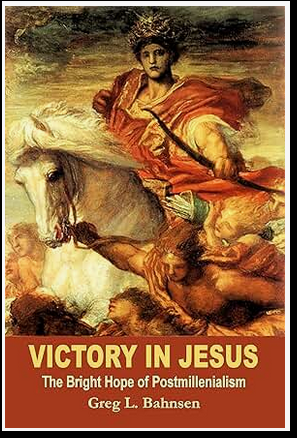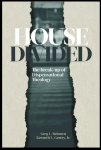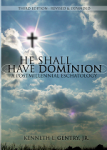A SUMMARY OF MILLENNIAL VIEWS
PMW 2025-028 by Greg L. Bahnsen
Gentry note: The following material is taken from Greg L. Bahnsen’s valuable study, “The Prima Facie Acceptability of Postmillennialism,” which is reprinted in his posthumously published collection of articles and lectures on postmillennialism as the book: Victory in Jesus: The Bright Hope of Postmillennialism. I highly recommend this book as a brief introduction to postmillennialism. The following is by Dr. Bahnsen.
The Distinctive Essentials of the Three Positions
In the preceding section of this discussion there was occasion to note that postmillennialism had been misrepresented in its basic position. This causes us to ask, just what are the fundamental differences among premillennialism, amillennialism, and postmillennialism? That is, what is the distinctive outlook of each position, its essential and central characteristic?
Here many people are prone to be misled, becoming entangled in questions which are subsidiary and indecisive with respect to the basic dogmatical outlook of a pre-, a-, and postmillennialism. What this means is that they take important exegetical issues pertaining to the millennial question and attempt to use them to delineate the three fundamental theological positions; however, these particular exegetical issues are not decisive for the central and general claims of the school of thought. Perhaps some examples would be helpful.
When we come to discuss the distinctive essentials of premillennialism, amillennialism, and postmillennialism, there are many interpretative questions pertaining to scriptural teaching about the millennium which, while very important for the Christian to consider, are not definitionally crucial at this particular topical point; that is because adherents of different basic schools of thought have agreed on particular answers to these questions. For instance, we can ask about the nature of the “first resurrection” of Revelation 20:5. Does it refer to a bodily resurrection, the regeneration of the believer, or his passage at death to the intermediate state in heaven? Such a question usually separates premillennialists from the other two positions, since premillennialism insists on the first option; however, adherents of both amillennialism and postmillennialism have been known to endorse each of the last two options. Likewise, the question of the imminency of Christ’s return tends to be answered in a cross-categorical manner; some premillennialists deny it in practice (post-tribulationists), while others propound it, just as amillennialists are split by those who accept it and those who reject it.
[image error]Why I Left Full-Preterism (by Samuel M. Frost)
Former leader in Full Preterist movement, Samuel M. Frost, gives his testimony and theological reasoning as to why he left the heretical movement. Good warning to others tempted to leave orthodox Christianity.
See more study materials at: KennethGentry.com
The question does not serve us well in the particular project of finding the distinctive essentials of each of the three eschatological schools. Further subsidiary or theologically indecisive issues would pertain to such things as whether the Christian martyrs receive a special blessing during the millennium, whether the millennium pertains to the intermediate state at all (amillennialists and postmillennialists have agreed in various ways on this question), whether the church is an expression of Christ’s kingdom (recent premillennialists have come to grant this point), whether a future period of unprecedented tribulation with a personal Anti-Christ awaits the world and/or church (all three positions have espoused, or can accommodate, such an opinion), whether the “one thousand” of Revelation 20 is symbolic or literal (again, all three positions have or could answer this both ways). Such questions as these are of momentous significance for the Christian in his faith and practice, and this writer has definite convictions on each one of them. However, these issues and many more like them are not the telling differences among the three theological schools of premillennialism, amillennialism, and postmillennialism.
In order to get down to the really basic differences among these three positions as distinct schools of thought we can begin by outlining their respective central claims.
Premillennialism
Premillennialism holds that (1) Christ will return physically prior to the millennium, and that (2) the millennium is a period of righteousness, peace and prosperity for Christ’s kingdom on the earth. There will be (3) a significant historical delay or gap between the return of Christ at the first resurrection and the judgment of the wicked at the second resurrection, just prior to the inauguration of the eternal state. (This gap corresponds to the millennial kingdom of earthly prosperity for God’s chosen people.) Therefore, (4) the millennium is distinct from the current church age, being a future interim period between Christ’s return and the final judgment.
(5) The specific nature of the millennial kingdom will be seen in the national prosperity of the restored Jewish state with Christ ruling bodily from Jerusalem and militarily subduing the world with the sword. (However, some premillennialists de-emphasize this Jewish element and simply stress that the millennium is a preparatory stage for the church; the Old Testament nation, the New Testament church, the millennium, and the eternal state are all seen as developing stages in the kingdom.) Thus, (6) the Old Testament prophecies of prosperity are required to be taken literally as pointing ahead to a Jewish state separate from the church and necessitating a radical discontinuity between Israel and the church. Finally, (7) the church’s preaching of the gospel through the whole earth prior to Christ’s return will prove to be of no avail culturally; the world will become a hopeless wreck, increasingly getting worse and worse, climaxing in the tribulation at the very end of the church age.
House Divided: The Break-up of Dispensational Theology By Greg Bahnsen and Ken Gentry
By Greg Bahnsen and Ken Gentry
This book presents and defends Christian Reconstruction theology, particularly theonomic ethics and postmillennial eschatology. It does to by responding to dispensationalism’s social and exegetical theology.
For more educational materials: www. KennethGentry.com
Amillennialism
By contrast, amillennialism says that (1) Christ will return after the millennium. (2) It maintains that there will be no millennium in the sense of a semi-golden era of earthly prosperity for the kingdom; instead, the millennium is restricted to the blessings of the intermediate (heavenly) state (some restricting its blessing to the martyrs there) and/or the purely inward spiritual triumphs experienced by the church on earth (i.e., Christ ruling in the believer’s heart). Basically then, amillennialism denies that there will be any visible or earthly expression of Christ’s reign over the entire world; as D. H. Kromminga says, “the millennium is a spiritual or heavenly millennium.” (Note: the church is a visible form of Christ’s kingdom in the world, according to many amillennialists; however, the church will not make all the nations disciples of Christ and gain a dominant or widespread influence throughout the world, but will rather remain a remnant of believers representatively spotted across the globe, which is unable to effect a period of [comparative] justice and peace.)
(3) The return of Christ at the end of the church age will synchronize with the general resurrection and general judgment of all men, believer and unbeliever alike. Therefore, (4) the millennium is the present interadventual age. (5) There will be no conversion or subduing of the world by Christ during the millennium, but rather the world will see a more or less parallel development of good and evil, with evil intensifying toward the end of the church age. Thus (6) the Old Testament prophecies of prosperity are required to be taken completely figuratively as pointing ahead to the eternal state or the internal spiritual condition of the church, thus propounding continuity between Old Testament Israel and the New Testament church. Finally, (7) the world is moving toward a time of increasing lawlessness, and the preaching of the gospel throughout the world will not achieve outstanding and pervasive success in converting sinners (i.e., the overall discipling of the nations).
Postmillennialism
Postmillennialism, as the name implies, holds that (1) Christ will return subsequent to the millennium, which (2) represents a period which will see growth and maturation of righteousness, peace, and prosperity for Christ’s kingdom on earth (visibly represented by the church) through the gradual conversion of the world to the gospel, as well as a period for the glory and vindication of the saints in heaven. (3) The return of Christ will synchronize with the general resurrection and general judgment at the end of the church age.

He Shall Have Dominion
(paperback by Kenneth Gentry)
A classic, thorough explanation and defense of postmillennialism (600+ pages). Complete with several chapters answering specific objections.
See more study materials at: www.KennethGentry.com
Therefore, (4) the millennium or kingdom of millennialists have used the eschatological vocabulary in such a way that the “millennium” represents the latter day, publicly discernible, prosperity of the interadventual “kingdom.”) (5) The specific nature of the millennial kingdom on earth will be the international prosperity of the church (new Israel), its growth (through the conversion of the world by the sword of the Spirit), and its influence in society and culture. Thus, (6) the Old Testament prophecies of prosperity for the kingdom are both figuratively and literally interpreted according to the demands of context (both local and wider) as pointing ahead not simply beyond the church age to a restored Jewish kingdom or the eternal state (thus rendering the visible church on earth something of a parenthesis for the most part), but to the visible prosperity of Christ’s established kingdom on earth, climaxing in the consummated glory of the eternal state; there is continuity between Old Testament Israel and the New Testament Church (new Israel), which eventually will include the fullness of converted physical Israel grafted back into the people of God.
Finally then, (7) over the long range the world will experience a period of extraordinary righteousness and prosperity as the church triumphs in the preaching of the gospel and discipling the nations through the supernatural agency of the Holy Spirit; however, the release of Satan at the very end of the age will bring apostasy from these blessed conditions.
To finish reading this material in full (with footnotes) check out the book at Amazon.
GOODBIRTH AND THE TWO AGES
I am currently researching a technical study on the concept of the Two Ages in Scripture. This study is not only important for understanding the proper biblical concept of the structure of redemptive history. But it is also absolutely essential for fully grasping the significance of the Disciples’ questions in Matthew 24:3, which spark the Olivet Discourse. This book will be the forerunner to a fuller commentary on the Olivet Discourse in Matthew’s comprehensive presentation. This issue must be dealt with before one can seriously delve into the Discourse itself.
If you would like to support me in my research, I invite you to consider giving a tax-deductible contribution to my research and writing ministry: GoodBirth Ministries. Your help is much appreciated!
Kenneth L. Gentry Jr.'s Blog
- Kenneth L. Gentry Jr.'s profile
- 85 followers



